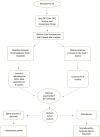How Successful Is Surgical Sperm Retrieval in Klinefelter Syndrome?
- PMID: 36303963
- PMCID: PMC9580639
- DOI: 10.3389/frph.2021.636629
How Successful Is Surgical Sperm Retrieval in Klinefelter Syndrome?
Abstract
Klinefelter Syndrome (KS) is characterized by the presence of an extra X chromosome. It was first diagnosed in 1942 in a group of azoospermic men. KS is the most common chromosomal abnormality encountered in infertile men and accounts for more than 10% of the causes of azoospermia. Men who are azoospermic may still father children via testicular sperm extraction followed by intracytoplasmic sperm injection (ICSI). This review article summarizes the success rates of the available techniques for surgical sperm retrieval (SSR) in KS including conventional testicular sperm extraction (cTESE) and micro testicular sperm extraction (mTESE), as well as the risks of these procedures for future fertility. The evidence indicates that the SSR rate is as successful in non-mosaic men with KS as those with normal karyotypes, with retrieval rates of up to 55% reported. The influence of different factors that affect the chances of a successful outcome are discussed. In particular, the impact of aneuploidy rate, physical characteristics, co-morbidities, reproductive endocrine balance and the use of different hormone management therapies are highlighted. Evidence is presented to suggest that the single most significant determinant for successful SSR is the age of the patient. The success of SSR is also influenced by surgical technique and operative time, as well as the skills of the surgeon and embryology team. Rescue mTESE may be used successfully following failed TESE in KS patients in combination with hormone stimulation.
Keywords: Klinefelter syndrome; MicroTESE; TESE; hormone stimulation; surgical sperm retrieval; testicular sperm extraction.
Copyright © 2021 Kailash, Raheem and Homa.
Conflict of interest statement
The authors declare that the research was conducted in the absence of any commercial or financial relationships that could be construed as a potential conflict of interest.
Figures
Similar articles
-
Outcome of testicular sperm extraction in nonmosaic Klinefelter syndrome patients: what is the best approach?Andrologia. 2016 Mar;48(2):171-6. doi: 10.1111/and.12428. Epub 2015 May 1. Andrologia. 2016. PMID: 25929757
-
Sperm recovery and ICSI outcomes in men with non-obstructive azoospermia: a systematic review and meta-analysis.Hum Reprod Update. 2019 Nov 5;25(6):733-757. doi: 10.1093/humupd/dmz028. Hum Reprod Update. 2019. PMID: 31665451
-
Sperm retrieval rates in non-mosaic Klinefelter patients undergoing testicular sperm extraction: What expectations do we have in the real-life setting?Andrology. 2020 May;8(3):680-687. doi: 10.1111/andr.12767. Epub 2020 Feb 16. Andrology. 2020. PMID: 31999885
-
Severe testicular atrophy does not affect the success of microdissection testicular sperm extraction.J Urol. 2014 Jan;191(1):175-8. doi: 10.1016/j.juro.2013.07.065. Epub 2013 Aug 1. J Urol. 2014. PMID: 23911635 Free PMC article.
-
Klinefelter syndrome and fertility: sperm preservation should not be offered to children with Klinefelter syndrome.Hum Reprod. 2016 Sep;31(9):1952-9. doi: 10.1093/humrep/dew179. Epub 2016 Jul 13. Hum Reprod. 2016. PMID: 27412247 Review.
Cited by
-
Factors influencing the sperm retrieval rate of microdissection testicular sperm extraction in patients with nonmosaic Klinefelter syndrome.Asian J Androl. 2023 Nov 1;25(6):704-707. doi: 10.4103/aja2022124. Epub 2023 Mar 31. Asian J Androl. 2023. PMID: 37005982 Free PMC article.
-
Update on Physical, Psychological, and Quality of Life Management in Klinefelter Syndrome.J Clin Endocrinol Metab. 2025 Jul 15;110(8):e2435-e2445. doi: 10.1210/clinem/dgaf261. J Clin Endocrinol Metab. 2025. PMID: 40314150 Free PMC article. Review.
-
Sperm extraction in nonmosaic Klinefelter syndrome patients: A case series and literature review of sperm extraction in Klinefelter syndrome patients.Urol Ann. 2024 Jul-Sep;16(3):241-246. doi: 10.4103/ua.ua_55_23. Epub 2024 Jul 3. Urol Ann. 2024. PMID: 39290228 Free PMC article.
-
Medical treatment prior to micro-TESE.Asian J Androl. 2025 May 1;27(3):342-354. doi: 10.4103/aja202492. Epub 2024 Dec 24. Asian J Androl. 2025. PMID: 39716721 Free PMC article. Review.
-
The Klinefelter Syndrome and Testicular Sperm Retrieval Outcomes.Genes (Basel). 2023 Mar 4;14(3):647. doi: 10.3390/genes14030647. Genes (Basel). 2023. PMID: 36980920 Free PMC article. Review.
References
-
- Klinefelter H, Reifenstein E, Albright F. Syndrome characterized by gynecomastia, aspermatogenesis without A-leydigism, and increased excretion of follicle-stimulating hormone. J Clin Endocrinol Metab. (1942) 2:615–27. 10.1210/jcem-2-11-615 - DOI
Publication types
LinkOut - more resources
Full Text Sources


